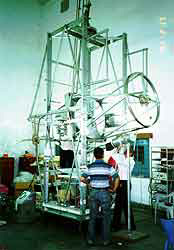TOP > Topics > 2001 > Indian Balloon Experiment
![]()
Indian Balloon Experiment
To observe infra-red rays from celestial bodies, a collaborative balloon experiment between India (Tata Basic Research Institute) and Japan (ISAS, Nagoya University, Tokyo University, and Communication Research Laboratory) has been underway since 1998. It succeeded in making its first observations in 1999. Preparations for two types of observation experiments proceeded in 2000. The balloons take off from Hyderabad balloon Base on the Deccan Plateau, India.

The first is an efficient, continuous wave observation using a 50cm-aperture telescope, developed in Japan, that carries an ASTRO-F two-dimensional infra-red array detector which acts as the validation model. The experiment team had been on site since November making preparations. Then, on December 16, at 11 PM standard Indian time, they successfully launched the balloon. For an observation time of four and a half hours, the balloon surveyed the Orion star forming region, etc. At the end of the experiment, the team returned temporarily to Japan.
Fortunately, the equipment was recovered almost completely unharmed. Another experiment was deemed necessary, and thus the experiment team returned to India in early February. This time, they had already proceeded with preparation for another experiment. The experiment aimed to perform high-resolution infra-red spectroscopic observation making use of a large aperture, and used the Japan-developed spectrometer mounted on a 1m aperture balloon telescope developed by the Tata Research Lab. Preparations for both observations were completed by mid February, and then the teams waited for a launch opportunity.
Gentle surface winds are required for a balloon launch. In India, since the surface winds do not let up during summer, it is imperative to launch balloons before the summer arrives. However, it seems that summer arrived earlier this year, unlike normal years. The surface winds never let up, no matter how long we waited, and the launch was abandoned and the team returned to Japan in mid March. The experiment should be repeated in the fall, and to this end the scientific instruments will be kept at the base.
July 3, 2001




